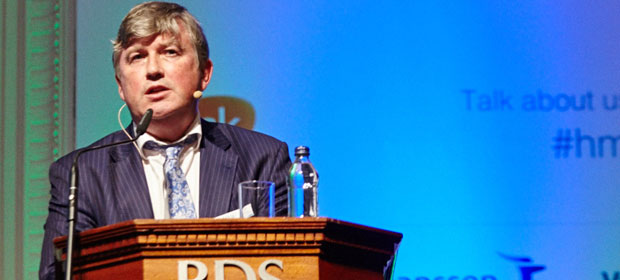Technology is a game changer and he thought connected health could deliver prompt and appropriate treatment of seriously ill patients in hospital and their return to their home as soon as possible, Prof. Seamas Donnelly, Chair of Clinical Medicine, Tallaght Hospital and Trinity College, Dublin, told the Conference.

Prof. Donnelly is one of the pioneers in Ireland in the use of technology to provide care in the community. He discussed its potential to change the point of health service delivery and the benefits these changes would have for service users and providers. He is recognized as an international leader in translational medicine and his research epitomizes classical bench to bedside on an international stage. The work of his research group is leading to novel therapies in respiratory disease, particularly in asthma, COPD and sarcoidosis.
He said connected health was a broad church. The Holy Grail was perhaps that we could get a suite of sensors that would act as a radar for an early warning system in the home or the community that would mean people did not have to go to hospital.
Donnelly is one of the pioneers in Ireland in the use of technology to provide care in the community.
“We will all be patients one day and when I am a patient I would like to stay in my home and my community living independently. I would like to keep that independence and maintain the quality of life as long as possible. When I get seriously ill I want to be treated promptly and appropriately and go home to my community as soon as possible.
“The elephant in the community is the escalating healthcare costs. If we put costs in perspective for every man, woman and child in the US just over 5,152 dollars was spent on Medicare (the federal health insurance program for people who are 65 or older, certain younger people with disabilities, and people with end-stage renal disease) in 2001. This had mushroomed to an estimated 12,019 dollars this year and was unsustainable.
The big ticket items were heart failure, Chronic Obstructive Pulmonary Disease (COPD), asthma, diabetes, and thrombosis, which accounted for over 80% of healthcare costs in the US on an annual basis.
The second big challenge is our aging population. In 2015 there were five million people in the US aged over 85. That would quadruple by 2050 and it would put a significant strain on maintaining services, improving quality and maintaining the independence of older citizens.
I could guesstimate that 30% of my patients are not taking their prescribed inhaler or they are not taking it properly.
Prof. Donnelly said that as well as being a Respiratory Physician he was a Cell and Molecular Biologist and companies came to him with new technology looking for areas of unmet clinical need and introductions to relevant clinicians in these areas.
“One of my own areas of unmet need concerns inhalers. I prescribe them in my
outpatients, but I have no idea if the patients are taking them and if they are working.
“International guidelines for Chronic Obstructive Pulmonary Disease (COPD) are about escalating therapy. Clinicians start with one or two inhalers, patients say it’s not working, then the therapy is escalated, but patients may be getting medication they don’t need and we may be spending money unnecessarily. I could guesstimate that 30% of my patients are not taking their prescribed inhaler or they are not taking it properly. Historically with that degree of non compliance there were trials where positive results were missed. If you included 1,000 patients in a trial where 30% were non-compliant you were really only looking at 70% of the patients.
“Now, we have developed a smart inhaler which can be customised and put into any inhaler. We have added functionality to assess pulse rate and we are adding other functionalities as we speak.”

